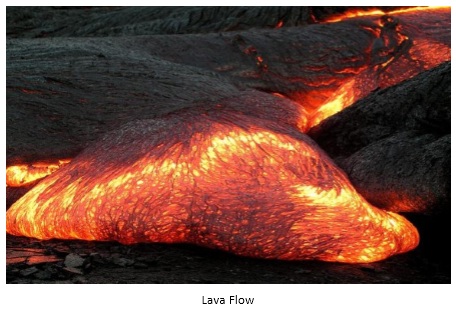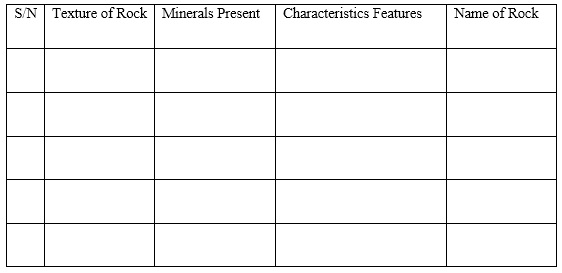Identification of Igneous Rocks
Introduction
Summarily, rocks are naturally occurring substances; coherent, solid aggregates of one or more minerals or mineraloids. They are composed of grains of minerals. Minerals are homologous solids formed from a chemical compound arranged in orderly manner. These minerals forming rocks are held together by chemical bonds.
There are three major types of rocks:
- Igneous Rocks
- Metamorphic Rocks
- Sedimentary Rocks
In this section, the identification of igneous rocks is discussed.
Igneous rocks are also called magmatic rocks. As this name implies, igneous rocks simply are rocks formed through the cooling and solidification of magma or lava. These magma can be derived from partial melts of existing rocks in either a planet’s mantle or crust. There are three ways by which melting is caused: an increase in temperature, a decrease in pressure, or a change in composition. When igneous rocks are formed, they solidify either below the surface or on the surface of the earth; in which case they are called intrusive rocks (or plutonic rocks) and extrusive rocks (or volcanic rocks) respectively. Igneous rocks may form with crystallization to form granular, crystalline rocks, or without crystallization to form natural glasses. The difference between magma and lava is that magma is molten rock beneath the surface of the earth while lava is molten rock on the surface of the earth. Igneous rocks are very hard rocks that have had a vast usefulness in building and construction for thousands of years. Examples of Igneous rocks include granite, andesite, diorite, rhyolite, gabbro, obsidian, pumice, basalt, etc.
Volcanic rocks (that is extrusive rocks) are fine-grained (or glass) due to their rapid solidification; intrusive rocks (plutonic) are generally coarse-grained, which indicates that the magma crystallized slowly underground. Experiments show that the slower cooling of liquids results in larger crystals. The preexisting solid rock into which the magma intrudes during the formation of plutonic rocks are called country rocks. Country rocks appear to have been forcibly broken by an intruding liquid, with the magma flowing into the fractures that developed. Country rock, incidentally, is an accepted term for any older rock into which an igneous body intruded.
Composition of Igneous Rocks
Since both crust and upper mantle are composed largely of silicate minerals, that is, minerals that contain both silicon and oxygen, igneous rocks also consist mostly of silicate minerals. Minerals found in rocks include quartz, olivine, orthoclase feldspar, plagioclase feldspar, amphibole, mica, etc.
The classification of igneous rocks based on their mineralogy is described below:
- Silicic rocks: These are also called or felsic rocks. They are generally light-colored (white, tan, pink, light grey). They are high in silica, potassium and aluminum; and low in iron and magnesium. The dominant minerals in these rocks are quartz and orthoclase feldspar. Biotite, amphibole, and plagioclase feldspar may also be present in small quantities. Olivine should not be present in silicic rocks.
- Intermediate rocks: They are usually medium to dark brown or grey (sometimes blackish) and are intermediate in silica, iron, and magnesium content. The dominant minerals are pyroxene and sodic plagioclase, but biotite and amphibole are also common.
- Mafic rocks: They are called basic rocks. They are usually dark-colored (black or dark green). They are low in silica; and high in iron, magnesium, and calcium. Mafic rocks are composed chiefly of pyroxene and calcic plagioclase; ultramafic rocks consist of pyroxene and olivine. Quartz should not be present in mafic rocks.
- Ultramafic rocks: They are rocks which are composed entirely or almost entirely of ferromagnesian minerals. No feldspars are present and, of course, no quartz. Peridotite, a coarse-grained rock composed of pyroxene and olivine, is the most abundant ultramafic rock. Chemically, these rocks contain less than 45% silica.
Textures of Igneous Rocks
The texture of rocks is a vital property for their identification and classification. Texture refers to a rock’s appearance with respect to the size, shape, and arrangement of its grains or other constituents. Most (but not all) igneous rocks are crystalline; that is, they are made of interlocking crystals (of, for instance, quartz and feldspar). The texture of an igneous rock reflects its cooling history, but may also be influenced by its chemical composition. The most significant aspect of texture in igneous rocks is grain (or crystal) size.
Extrusive rocks are typically fine-grained rocks, in which most of the grains are smaller than 1 millimeter. The grains of these rocks, if they are crystals, are small because as described above, magma cools rapidly at the Earth’s surface, and so they have less time to form. Some plutonic rocks are also fine-grained; this occurs when these rocks solidify near the surface upon intrusion into relatively cold country rock (probably within a couple kilometers of the Earth’s surface). Types of fine grained igneous rocks include: Basalt, andesite, and rhyolite.
As discussed above, because of their great depth of solidification, plutonic rocks are mostly coarse-grained. This is because at these depths, they solidify slowly. According to Carlson et al (2011), the crystals or grains of most fine-grained rocks are considerably smaller than 1 millimeter and cannot be distinguished by the unaided eye. So, for practical purposes, if you can discern the individual grains, regard the rock as coarse-grained; if not, consider it fine-grained.
Different textures of rocks are described below:
- Aphanitic Texture: A rock is aphanitic when the individual grains are too small to be recognized or identified. As explained, aphanitic igneous rocks are of volcanic (extrusive) origin.
- Phaneritic Texture: A rock is phaneritic when the individual grains are visible, more or less the same general size, and interlock like elements of a jigsaw puzzle.
- Porphyritic Texture: A porphyritic rock refers to large, more-or-less well-formed crystals (called phenocrysts) surrounded by a fine-grained or aphanitic material (the groundmass). Thus, in porhyritic rocks, large crystals are enclosed in a groundmass of finer-grained crystals or glass.
- Vesicular Texture: These are light rocks with bubble holes (vesicles) formed by escaping gas. They indicate a volcanic origin.
Objective of the Experiment
This procedure is carried out to identify igneous rocks
Identification of Igneous Rocks
Plutonic rocks are easier to identify than extrusive rocks because of their larger mineral grains. The physical properties of each mineral in a plutonic rock can be determined more readily. And, of course, knowing what minerals are present makes rock identification a simpler task. As explained above, the texture and mineralogy knowledge of the rock helps in the identification of the rocks. The properties of some common igneous rocks are described below:
- Gabbro: Gabbro is an intrusive igneous rock that formed by magma that cools very slowly into hard rock below or within the Earth’s crust. It is formed of coarse-grained ferromagnesian minerals and gray, plagioclase feldspar. Ferromagnesian minerals are silicates that contain iron and magnesium —amphibole, pyroxene, olivine, and biotite. It is dark grey-black, has shiny surfaces of visible feldspar.
- Basalt: This is the extrusive counterpart of gabbro. It is composed of feldspar, olivine, pyroxene, and amphibole. Basalt is solidified lava, like rhyolite. However, it flows much quicker because it is less viscous. Its characteristics include dark-grey to black colour, frothy with small visible holes where gas escaped while the lava cooled.
- Granite: Granite is an intrusive igneous rock that formed by magma that cools very slowly into hard rock below or within the Earth’s crust. It is composed of feldspar, quartz, mica, and hornblend. Its characteristics include visible crystals of pink feldspar, white or grey quartz, and black mica. There is no horizontal banding in granite. Granite is the most abundant intrusive rock found in the continents.
- Rhyolite: This is an extrusive counterpart of granite. Rhyolite is formed by magma that has reached the Earth’s surface (lava) and therefore cools very quickly. It is composed predominantly of feldspars (usually white or pink) and quartz.
- Diorite: Diorite is an intrusive igneous rock composed of feldspars and significant amounts of ferromagnesian minerals (30–50%). The minerals can be identified and their percentages estimated to indicate diorite. It has a medium-gray or medium-green colour.
- Andesite: This is the extrusive counterpart of diorite.
For ease of classification and identification, a tabulated form can be made as shown below:
References
- Carlson, D.H., Plummer, C.C., and Hammersley, L. (2011). “Physical Geology: Earth Revealed” The McGraw-Hill Companies, Inc., 1221 Avenue of the Americas, New York, NY 10020.
- Lab 4 : Identification of Igneous Rocks
- Lab 3: Textures and Identification of Igneous Rocks
- miningmatters.ca. “Rock Identification Guide”.
Credits: Samuel Alalade. Obafemi Awolowo University, Ile-Ife, Osun State, Nigeria.


